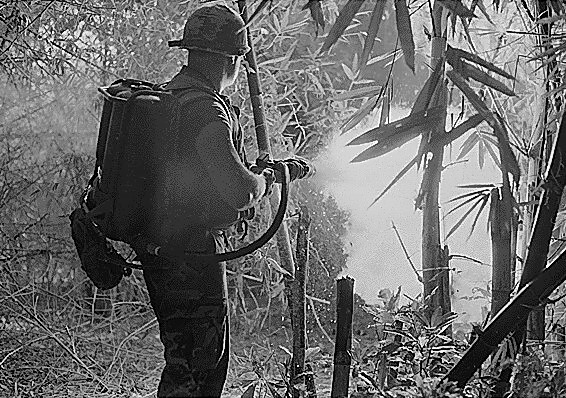
Historical Tales | News | Vampires | Zombies | Werewolves
Virtual Academy | Weapons | Links | Forum
Vampires in the Vietnam War
by Luke Costagliola, with additional contributions from Hugo Pecos.The difficulties of American troops during the Vietnam War often are attributed to the skillful tactics of its opponent and the lack of support on the homefront. But U.S. forces were hampered by another stealthy enemy in southeast Asia: vampires.
From the beginning, combat in Vietnam's jungles presented new challenges for American troops. The army in particular was trained and equipped for a conventional, mechanized war such as what they had faced in Europe, and Vietnam, with its jungle fighting, was a new game. The Viet Cong were masters of guerilla warfare, during which they would hit troops with surprise attacks and then recede back into the jungle. They also effectively used small villages as bases and ammunition stores.
In an attempt to turn the tables, the U.S. Marine Corps developed a Civil Operations and Revolutionary Development Support, or CORDS, program, which assigned small units to patrol the villages. The Marines sought to recruit members of indigenous tribes in the mountainous region of west Vietnam to help them. But the Marines quickly discovered that the tribes were fearful of venturing into certain areas because of the presence of "ma," or phantoms. One tribe in particular—the Montagnard—spoke of reanimated corpses that haunted the jungle, drinking the blood and consuming the internal organs of people unlucky enough to cross their paths. U.S. commanders were quick to dismiss the claims as local superstition.
Alas, it wasn't superstition at all. Reports of troop encounters with ghouls in the jungle began trickling in to U.S. command around 1965. At first, the stories involved troops catching glimpses of ghostly figures moving through the jungle. Soldiers who saw these creatures described them as having fangs and black eyes. And then, soldiers began to disappear from their platoons. In one incident, two American soldiers rescued one of their comrades from a creature that appeared to be impervious to their bullets.
U.S. commanders initially suspected vampires, as Vietnam, home to 41 known species of bats, had a history of outbreaks. One person infected in an isolated jungle villages with no access to vaccine could quickly spread the affliction through an entire community.
 |
| Flamethrowers were key to vampire "mop up" efforts during the Vietnam War. |
With troop morale plummeting and the Viet Cong making gains, top Army brass brought several high-ranking FVZA agents to Saigon in the fall of 1966 for a consultation. The Army helicoptered the agents out to the village at Son Hao, scene of the daytime battle between U.S. troops and the ghouls. Once there, the agents noticed that the triple canopy jungle was filtering almost all of the sunlight before it reached the ground. They speculated that this filtering was enabling the vampires to operate in daytime.
In a report to President Lyndon B. Johnson, the FVZA concluded that eliminating the vampires would be virtually impossible in Vietnam's jungle settings.
When Johnson read the conclusion, he famously said, "if the jungle's the problem, then let's get rid of the damn jungle."
Thus began the infamous Vietnam Herbicial Warfare program. The military chose a defoliant known as Agent Orange and sprayed 20 million gallons of it over 6 million acres of jungle. Once the canopy was denuded, troops went into suspect villages with flamethrowers to exterminate any remaining vampires.
The program was successful in clearing several large packs of vampires from the mountainous regions of Vietnam. However, many American soldiers and their Montagnard allies remained unwilling to go into the jungle villages.
As a result, the Marine Corps abandoned the CORDS program in 1968 and returned to a policy almost indistinguishable from the army's. And Vietnam's jungles were left to the Viet Cong, the indigenous tribes...and the vampires.